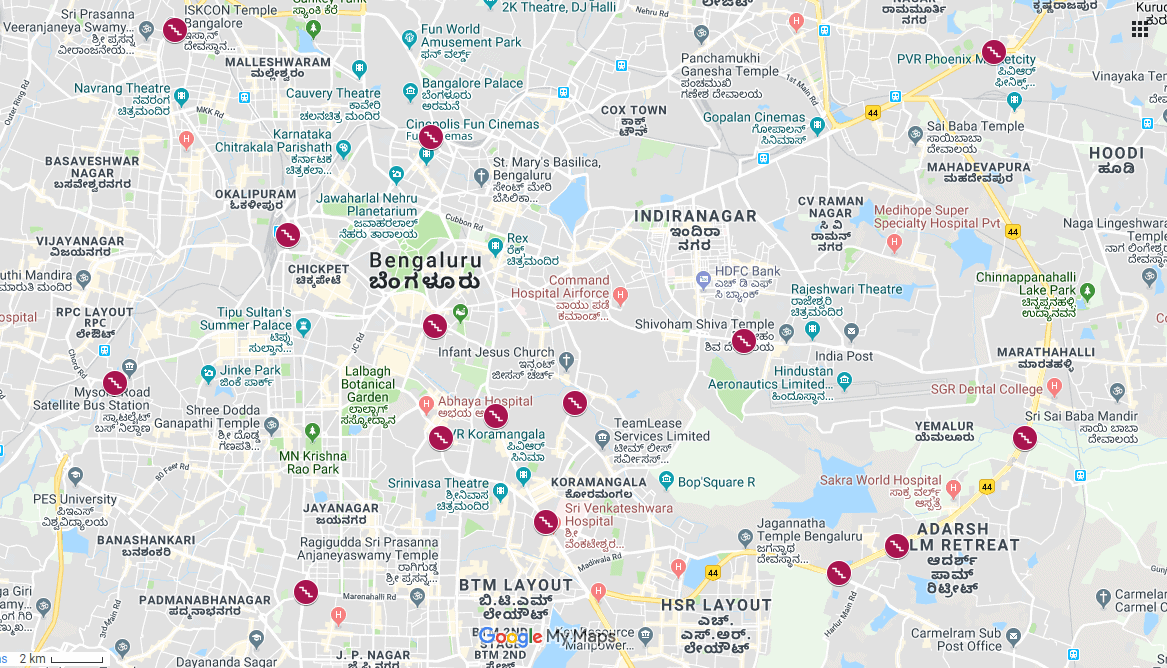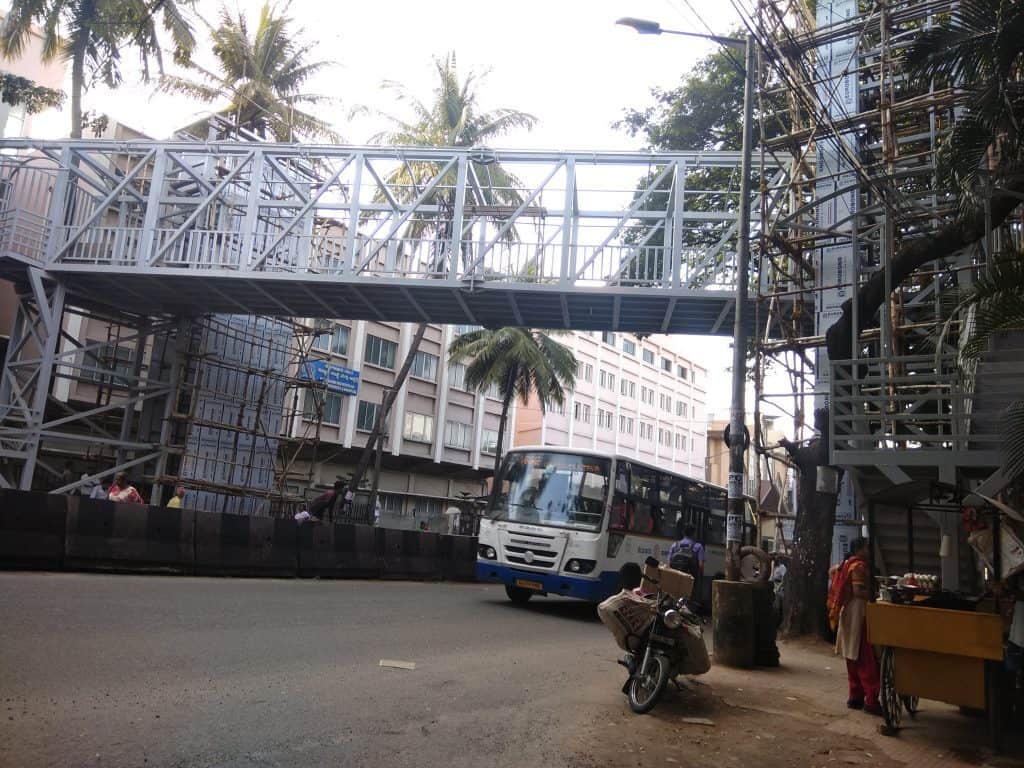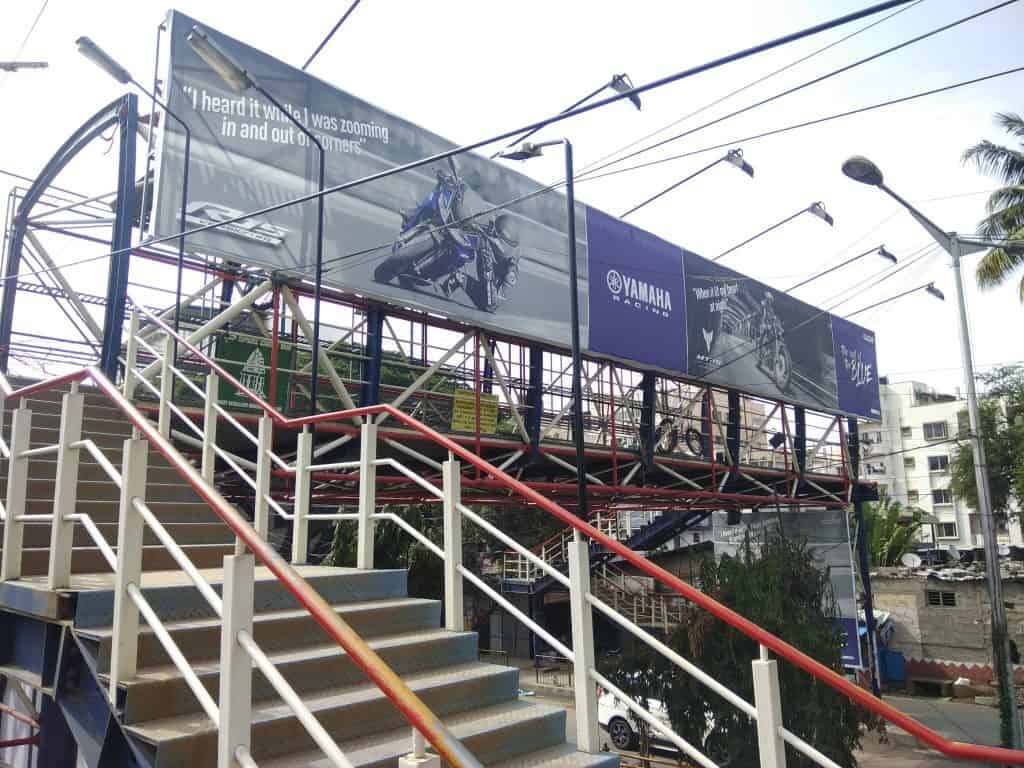In 2012, Bengaluru got its first skywalk with elevators on KG Road. Today, the city has 21 skywalks equipped with lifts on both sides, and CCTV cameras. Another 15 of these will be set up by the end of this year. This would take the total number of skywalks with lifts in Bengaluru to 36.
The lifts are helpful especially for the elderly and others who have difficulty climbing stairs. Septuagenarian Madhukar Swamy, a retired government servant, says he uses lifts in the skywalk near BBMP head office almost every day. “Sometimes, if I feel well, I take the stairs while coming down. But I have to take the lift while going up, due to my age,” he says.
M V Srinivas, BBMP Executive Engineer (Road Infrastructure – Special Division), says that, of the 15 upcoming lifts, three will be in the east zone, and four each in the west, south and Mahadevapura zones.

Map showing the locations where the new skywalks are being constructed
Srinivas says BBMP has issued tenders for another 14 skywalks as well.
The city also has 18 skywalks that do not have lifts or CCTV cameras, and one that has an escalator. Overall, 40 skywalks – with or without lifts – are operational currently.
How are skywalks built and maintained?
Of the 40 skywalks in the city, 30 were built in the PPP model. This includes all skywalks that have lifts. A skywalk with two lifts costs Rs 2.5-3 crore to build. The remaining 10 skywalks were built either by the BDA or by private parties like Brigade or ORRCA (Outer Ring Road Companies Association).
In case of skywalks built in the PPP model, BBMP invites bids from reputed firms/agencies to design, build, finance, operate and maintain the skywalk for 30 years. After 30 years, the skywalk will be handed over entirely to the BBMP.

A skywalk under construction near St Joseph College on Hosur road, near Lalbagh
Srinivas says, “We usually give the work order to bidders who give us the maximum ground rent. BBMP leases the land to them for 30 years, and the rent they pay us every year will be part of our revenue from skywalks.”
The construction cost, operating and maintenance costs of the entire structure, which includes electricity, back-up power, personnel, repairs etc., shall be borne by the private agency. The agency will be offered commercial advertisement rights, as per BBMP bye-laws, to earn revenues for a concession period of 30 years which includes the construction period. Advertisements are the only source of revenue for the agency. The agency pays taxes on this advertisement revenue, to the BBMP.

A skywalk on Old Airport road. Advertisement tax from skywalks is a revenue source for BBMP
The 30 skywalks built in the PPP model has brought the BBMP revenue of around Rs 3.1 crore every year. Around Rs 1.47 crore of the total revenue each year was through advertisement tax and Rs 1.63 cr was from the ground rent paid by the private partner.
What facilities are provided in skywalks with lifts?
According to Srinivas, CCTV cameras and a generator of 25 KW capacity should be installed in all skywalks with elevators. A security guard, who is trained to operate the lift and help pedestrians in need, should be employed by the agency 24X7. As per the BBMP records till 16th of this month, all lifts and CCTV cameras were in working condition.
At the eight skywalks I visited, all elevators were in working condition, but only one was manned by a guard. At other skywalks, the guards were either not present or were not visible to the public.
What happens in case of an emergency?
When I called up the four phone numbers given on the wall of the skywalk in front of Christ College on Hosur Main Road, two were out of order, one was unanswered, and only one was answered.
On condition of anonymity, the person on the other side said the number belonged to the elevator company. And that when people called during an emergency, they would first ask the security guard to help the victim; the guard is given training for rescue.
In case of power cut, the Automatic Rescue Device (ARD) in the lift will provide enough electricity for the lift to automatically stop with its doors open, at the nearest floor. If this system fails, a buzzer goes off and the security guard, who would have been trained to release the brakes, will make the lift stop at the nearest floor. After this, the company will send technicians to fix the problem.
When asked about the maintenance of the elevators, the source said the company conducts periodic maintenance and safety inspections every month, along with a managerial-level check once a year.
Security guards missing at many skywalks, users say
Sanjukta Das and Bhavya Rani, who work at Embassy Golf Link Business Park adjacent to KGA golf course, say they regularly use the skywalk across the intermediate ring road nearby, but not the elevator as much. “When we are in a group we do take the elevator. But usually we just take the stairs as it is quicker and we need not wait on the crowded footpath.”

A man walks out of an elevator in a skywalk in Bengaluru
When asked if they feel safe taking the skywalk or the elevator, Sanjukta says she has never faced any problem, especially since she has used the skywalk during work hours. “I had no clue that there is a dedicated security guard for the skywalk,” Bhavya says.
Sakeer Ahmed, a businessman and resident of Murgesh Palya, says he uses the lift in the skywalk near Kemp Fort Mall across the Old airport road regularly. Sakeer goes to MG Road to get goods for his shop; while returning he alights at the Murgesh Palya bus stand with the goods and takes them in the lift to get to the other side of the skywalk. From here, his assistant loads the goods on his bike. “As far as I remember, there were perhaps one or two days when the lift did not work. Otherwise, it works well,” he says. Sakeer too has never seen a security guard at the skywalk.
Vijay Sourabh Singh, a Bengalurean who is now studying in the US, says he once saw a person urinating at a corner of a skywalk, but there was no guard to reprimand him. However, Madhukar Swamy says he has seen a security guard manning the skywalk he uses.
When asked what the civic body can do to ensure a security guard is posted at every skywalk, Srinivas claims that all skywalks do have guards. He further says that employing the guard is the responsibility of the private agency that maintains the skywalk. “We can only ask the agency to keep a security guard. In case of complaints, the public has to contact the private agency. If the skywalk is maintained by us, we will ensure a guard is placed there.”
Sky walks are failure in almost all the Countries. People prefer to cross the roads in zebra crossings when they are marked in required places, with automatic electric signals. To build and maintain skywalks with elevators are expensive. Most of the development works taken by BBMP seems to be for giveing work to Contractors.
Bangalore should have a Minister to plan and monitor the development.work.
Nice information to go through. We need a portal like this to solve and take a solution on the issues? Thank you citizenmatters